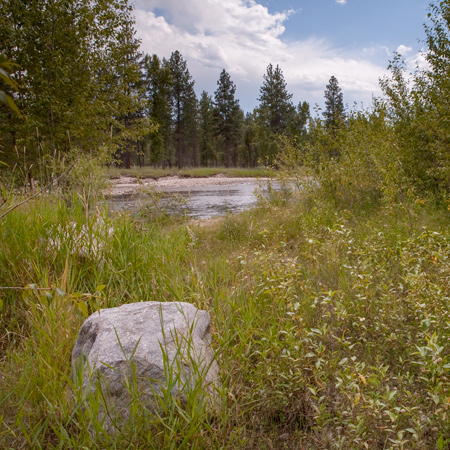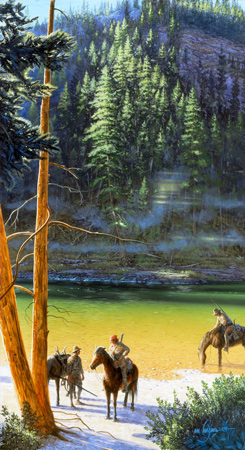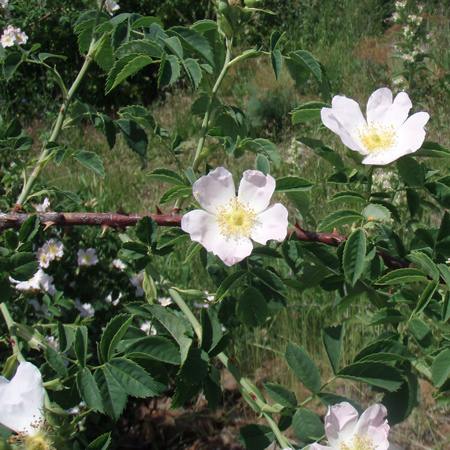The expedition is divided into two groups, and today, both follow dangerous roads:[1]For more on the captains’ strategy and various groups after leaving Travelers’ Rest, see Dividing Forces at Travelers’ Rest.
On the Blackfoot River, Lewis’s Nez Perce guides warn him about the dangerous Blackfeet Indians and decline to continue. He travels east on “Cokahlahishkit”—the Road to the Buffalo—for eight miles. He also collects a specimen of mock orange, a species named in his honor.
On the Bitterroot River, Clark’s group must cross several feeder creeks swollen from snows melting in the nearby Bitterroot Mountains. They celebrate the Fourth of July with a “Sumptious Dinner”.
No Celebration
by Yellowstone Public Radio[2]Originally aired weekdays by Yellowstone Public Radio during the Bicentennial observance of 2003-2006. Narrated by Hal Hansen. Scripts by Whit Hansen and Ed Jacobson. Produced by Leni Holliman. © … Continue reading
Crossing the Blackfoot River
© Michael Haynes, https://www.mhaynesart.com. Used with permission.
Lewis Among the “Enemies”
Palouse Traveler
at 6. A. M. a man of the Pallote pellows [Palouses] arrived from the West side of the Rocky mountains; he had pursued us a few days after our departure and overtook us at this place; he proved to be the same young man who had first attempted to pass the rocky mountains early in June last when we lay on the Kooskooske and was obliged to relinquish the enterprize in consequence of the debth and softness of the snow.
—Meriwether Lewis
Nez Perce Goodbyes
I gave a shirt a handkercheif and a small quantity of ammunition to the [Nez Perce] Indians . . . . I now ordered the horses saddled smoked a pipe with these friendly people and at noon bid them adieu.
—Meriwether Lewis
A Dangerous Road
these affectionate people our guides betrayed every emmotion of unfeigned regret at seperating from us; they said that they were confidint that the Pahkees, (the appellation they give the Minnetares [Atsinas]) would cut us off.
—Meriwether Lewis
Road to the Buffalo
I now continued my rout up the N. side of the Cokahlahishkit river through a timbered country for 8 miles and encamped in a handsom bottom on the river where there was an abundance of excelence grass for our horses. the evening was fine, air pleasent and no musquetoes.
—Meriwether Lewis
Richardson’s Ground Squirrel
a few miles before we encamped I killed a squirrel of the speceis common to the Rocky Mountains and a ground squirrel of a speceis which I had never before seen, I preserved the skins of both of these animals.
—Meriwether Lewis
Bitterroot River at Blodgett Creek

© 25 July 2011 by Kristopher K. Townsend. Permission to use granted under the Creative Commons Attribution-Share Alike 4.0 International license.
Clark on the Bitterroot
Dangerous Creek Crossings
after Dinner we proceeded on about one mile to a very large Creek which we assended Some distance to find a foard to cross in crossing this creek Several articles got wet, the water was So Strong, alto’ the debth was not much above the horses belly, the water passed over the backs and loads of the horses. those Creeks are emensely rapid has great decnt [descent] the bottoms of the Creek as well as the low lands on each Side is thickly covered with large Stone.
—William Clark
Celebrating the Fourth
This being the day of the decleration of Independence of the United States and a Day commonly Scelebrated by my Country I had every disposition to Selebrate this day and therefore halted early and partook of a Sumptious Dinner of a fat Saddle of Venison and Mush of Cows (roots)
—William Clark
West Fork Bitterroot Camp
continued on the road passing up on the W. Side of Clarks river 13 miles to the West fork of Sd. river and Encamped on an arm of the same I Sent out 2 men to hunt, and 3 in Serch of a foard to pass the river.
—William Clark
Lewis’s Mock Orange (Syringa)
Philadelphus lewisii
Lolo Trail above Kamiah, Idaho, 22 June 2008. © Kristopher K. Townsend. Permission to use granted under the Creative Commons Attribution-Share Alike 4.0 International license.
Mock Orange Specimen
On the waters of Clarks R Jul. 4th 1806.
—Meriwether Lewis[3]Philadelpus Lewisii. Moulton, ed. Herbarium, specimen 159.
Weather Diaries
State of the weather at rise
Wind at rise
State of the weather at 4 P. M. Wind at 4 P. M. fair S E fair N W —Meriwether Lewis
State of the weather at Sun rise Wind at Sun rise State of the weather at 4 P. M Wind at 4 P M. fair S W fair S W a worm day. I saw a Speces of Honeysuckle with a redish brown flower in blume
—William Clark[4]To assist the reader of this web page, the date column is omitted and some abbreviations have been spelled out.
Notes
| ↑1 | For more on the captains’ strategy and various groups after leaving Travelers’ Rest, see Dividing Forces at Travelers’ Rest. |
|---|---|
| ↑2 | Originally aired weekdays by Yellowstone Public Radio during the Bicentennial observance of 2003-2006. Narrated by Hal Hansen. Scripts by Whit Hansen and Ed Jacobson. Produced by Leni Holliman. © 2003 by Yellowstone Public Radio. |
| ↑3 | Philadelpus Lewisii. Moulton, ed. Herbarium, specimen 159. |
| ↑4 | To assist the reader of this web page, the date column is omitted and some abbreviations have been spelled out. |


